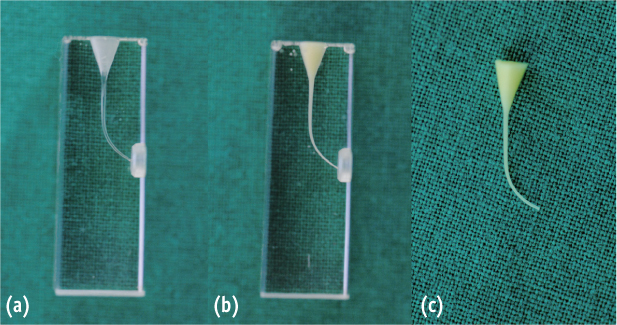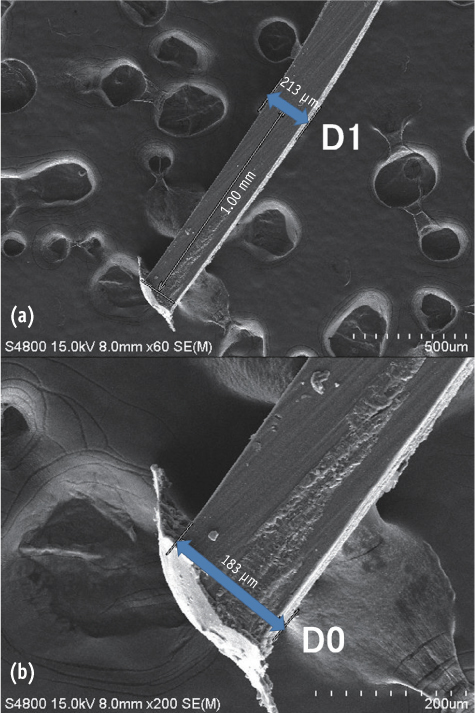Restor Dent Endod.
2015 May;40(2):123-127. 10.5395/rde.2015.40.2.123.
Effect of repetitive pecking at working length for glide path preparation using G-file
- Affiliations
-
- 1Department of Conservative Dentistry, School of Dentistry, Kyungpook National University, Daegu, Korea.
- 2Department of Conservative Dentistry, Pusan National University School of Dentistry and Dental Research Institute, Yangsan, Korea. golddent@pusan.ac.kr
- 3Department of Dentistry, Endodontic Unit, Dubai Health Authority, Dubai, UAE.
- 4Department of Conservative Dentistry, School of Dentistry, Kyung Hee University, Seoul, Korea.
- KMID: 2148861
- DOI: http://doi.org/10.5395/rde.2015.40.2.123
Abstract
OBJECTIVES
Glide path preparation is recommended to reduce torsional failure of nickel-titanium (NiTi) rotary instruments and to prevent root canal transportation. This study evaluated whether the repetitive insertions of G-files to the working length maintain the apical size as well as provide sufficient lumen as a glide path for subsequent instrumentation.
MATERIALS AND METHODS
The G-file system (Micro-Mega) composed of G1 and G2 files for glide path preparation was used with the J-shaped, simulated resin canals. After inserting a G1 file twice, a G2 file was inserted to the working length 1, 4, 7, or 10 times for four each experimental group, respectively (n = 10). Then the canals were cleaned by copious irrigation, and lubricated with a separating gel medium. Canal replicas were made using silicone impression material, and the diameter of the replicas was measured at working length (D0) and 1 mm level (D1) under a scanning electron microscope. Data was analysed by one-way ANOVA and post-hoc tests (p = 0.05).
RESULTS
The diameter at D0 level did not show any significant difference between the 1, 2, 4, and 10 times of repetitive pecking insertions of G2 files at working length. However, 10 times of pecking motion with G2 file resulted in significantly larger canal diameter at D1 (p < 0.05).
CONCLUSIONS
Under the limitations of this study, the repetitive insertion of a G2 file up to 10 times at working length created an adequate lumen for subsequent apical shaping with other rotary files bigger than International Organization for Standardization (ISO) size 20, without apical transportation at D0 level.
Figure
Reference
-
1. Sonntag D, Guntermann A, Kim SK, Stachniss V. Root canal shaping with manual stainless steel files and rotary Ni-Ti files performed by students. Int Endod J. 2003; 36:246–255.
Article2. Sattapan B, Nervo GJ, Palamara JE, Messer HH. Defects in rotary nickel-titanium files after clinical use. J Endod. 2000; 26:161–165.
Article3. Alapati SB, Brantley WA, Svec TA, Powers JM, Nusstein JM, Daehn GS. SEM observations of nickel-titanium rotary endodontic instruments that fractured during clinical Use. J Endod. 2005; 31:40–43.
Article4. Berutti E, Negro AR, Lendini M, Pasqualini D. Influence of manual preflaring and torque on the failure rate of ProTaper rotary instruments. J Endod. 2004; 30:228–230.
Article5. Patiño PV, Biedma BM, Liébana CR, Cantatore G, Bahillo JG. The influence of a manual glide path on the separation rate of NiTi rotary instruments. J Endod. 2005; 31:114–116.
Article6. Ha JH, Park SS. Influence of glide path on the screwin effect and torque of nickel-titanium rotary files in simulated resin root canals. Restor Dent Endod. 2012; 37:215–219.
Article7. Ruddle CJ. The ProTaper technique. Endod Top. 2005; 10:187–190.
Article8. West J. Endodontic update 2006. J Esthet Restor Dent. 2006; 18:280–300.
Article9. Ruddle CJ. Cleaning and shaping the root canal system. In : Cohen S, Burn RC, editors. Pathway of the pulp. 8th ed. St. Louis, MO: Mosby Elsevier;2002. p. 231–292.10. Bahcall JK, Carp S, Miner M, Skidmore L. The causes, prevention, and clinical management of broken endodontic rotary files. Dent Today. 2005; 24:74–80.11. Lopes HP, Elias CN, Siqueira JF Jr, Soares RG, Souza LC, Oliveira JC, Lopes WS, Mangelli M. Mechanical behavior of pathfinding endodontic instruments. J Endod. 2012; 38:1417–1421.
Article12. Yun HH, Kim SK. A comparison of the shaping abilities of 4 nickel-titanium rotary instruments in simulated root canals. Oral Surg Oral Med Oral Pathol Oral Radiol Endod. 2003; 95:228–233.
Article13. Park H. A comparison of Greater Taper files, ProFiles, and stainless steel files to shape curved root canals. Oral Surg Oral Med Oral Pathol Oral Radiol Endod. 2001; 91:715–718.
Article14. Arens FC, Hoen MM, Steiman HR, Dietz GC Jr. Evaluation of single-use rotary nickel titanium instruments. J Endod. 2003; 29:664–666.15. Cheung GSP. Instrument fracture: mechanisms, removal of fragments, and clinical outcomes. Endod Top. 2007; 16:1–26.
Article16. West JD. The endodontic Glidepath: "Secrets to rotary safety". Dent Today. 2010; 29:86–93.17. Blum JY, Machtou P, Ruddle C, Micallef JP. Analysis of mechanical preparations in extracted teeth using ProTaper rotary instruments: value of the safety quotient. J Endod. 2003; 29:567–575.
Article18. Peters OA, Peters CI, Schönenberger K, Barbakow F. ProTaper rotary root canal preparation: effects of canal anatomy on final shape analysed by micro CT. Int Endod J. 2003; 36:86–92.
Article19. Berutti E, Cantatore G, Castellucci A, Chiandussi G, Pera F, Migliaretti G, Pasqualini D. Use of nickel-titanium rotary PathFile to create the glide path: comparison with manual preflaring in simulated root canals. J Endod. 2009; 35:408–412.
Article20. Wu MK, R’oris A, Bakis D, Wesselink PR. Prevalence and extent of long oval canals in the apical third. Oral Surg Oral Med Oral Pathol Oral Radiol Endod. 2000; 89:739–743.
Article21. Bürklein S, Tsotsis P, Schäfer E. Incidence of dentinal defects after root canal preparation: reciprocating versus rotary instrumentation. J Endod. 2013; 39:501–504.
Article
- Full Text Links
- Actions
-
Cited
- CITED
-
- Close
- Share
- Similar articles
-
- Influence of glide path on the screw-in effect and torque of nickel-titanium rotary files in simulated resin root canals
- Comparison of the ability of Reciproc and Reciproc Blue instruments to reach the full working length with or without glide path preparation
- Influence of glide path size and operating kinetics on time to reach working length and fracture resistance of Twisted File adaptive and Endostar E3 nickel-titanium file systems
- Canal preparation with nickel-titanium or stainless steel instruments without the risk of instrument fracture: preliminary observations
- Influence of a glide path on the dentinal crack formation of ProTaper Next system



